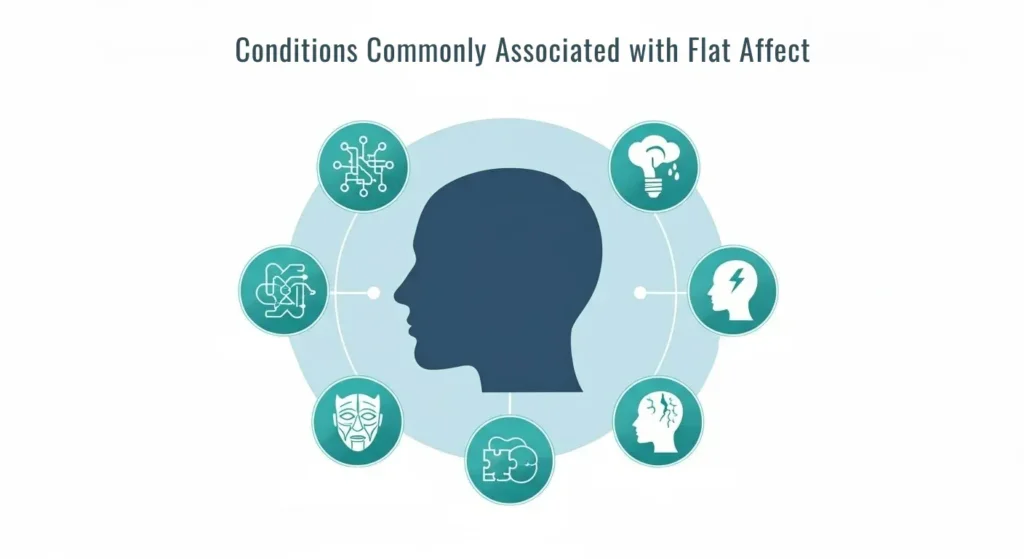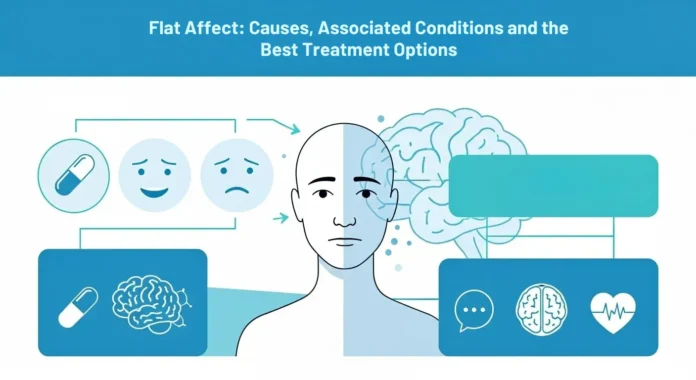Abstract: Flat affect is a reduced outward display of emotion through facial expression, voice tone, and body language. It is a symptom, not a condition itself, and can be caused by underlying issues like schizophrenia, severe depression, PTSD, autism, Parkinson’s disease, or brain injury. Treatment focuses on addressing the root cause, often combining medication, therapy, and social skills training to help improve emotional expression.
Have you ever spoken to someone and felt like you were talking to a wall, no smile, no frown, no eyebrow raise, not even a twitch of expression. It’s not always rude. Sometimes, it’s something called flat affect, a clinical term used when a person shows very little outward emotion, even if they’re feeling it internally.
What Is Flat Affect
Flat affect refers to a noticeable reduction or absence of emotional expression:
- Lack of facial movement
- Monotone speech
- Limited gestures and reactions
- Minimal changes in body language
Someone with flat affect might feel emotions internally but you wouldn’t know it by looking at them. This is different from apathy (not feeling emotions at all) or social withdrawal (choosing not to interact). In flat affect, emotions exist they’re just not showing.
Flat Affect vs. Blunted Affect vs:
| Term | What It Means | Emotional Feeling Present | Visible Emotion |
| Flat Affect | Almost no visible emotional expression | Yes (often) | Very little |
| Blunted Affect | Some expression, but much less than expected | Yes | Reduced |
| Masked Affect | Expression is hidden intentionally (e.g., pretending to be fine) | Yes | Controlled |
What Causes Flat Affect
Flat affect usually happens when the brain regions responsible for emotional expression and communication are disrupted. This can be due to:
Neurological Change
Parts of the brain such as the prefrontal cortex, basal ganglia, and limbic system regulate emotional expression. Injury, disease, or chemical imbalance in these areas can make emotional signals harder to express even if the person is mentally aware of how they should react.
Dopamine and Serotonin Imbalances
These neurotransmitters regulate motivation and emotional tone. When levels drop due to depression, medications, or disorders like schizophrenia facial and vocal expression can unintentionally “shut down.”
Learned Response to Trauma
In people with PTSD or long-term stress, flat affect can be a protective shield. When life feels dangerous, the brain learns to “go numb” to survive emotionally.
Conditions Commonly Associated with Flat Affect

Flat affect is most commonly linked to the conditions below. Some people may have more than one at the same time.
Schizophrenia and Schizoaffective Disorder
Flat affect is a core negative symptom of schizophrenia. In fact, doctors often use it as part of their diagnostic criteria.
Depression (Especially Severe or Chronic)
Not everyone with depression cries all day. For many, emotions go silent, leading to an expressionless face and slow speech.
Parkinson Disease
A condition often misunderstood as purely movement-related, Parkinson’s also affects facial muscles and emotional signaling, leading to what doctors call “masked facies.”
Autism Spectrum Disorder (ASD)
Some autistic individuals may show atypical emotional expression either more subtle or differently timed which can be misinterpreted as flat affect.
Traumatic Brain Injury (TBI)
Injuries to the frontal lobe or right hemisphere can interrupt emotional control. Loved ones might feel like the person’s “personality changed overnight.”
Can Medications Cause Flat Affect
Yes especially antipsychotics, antidepressants, and central nervous system sedatives. These drugs can reduce overactivity in the brain (which is good when someone is anxious or manic), but sometimes they overshoot and dull emotional responsiveness.
| Medication Type | Possible Effect on Affect | Reversible |
| Antipsychotics (e.g., Risperidone, Olanzapine) | May reduce expressiveness | Often Yes |
| SSRIs (e.g., Prozac, Zoloft) | Emotional “numbing” or apathy | Yes, with adjustment |
| Benzodiazepines (e.g., Xanax) | Slows responses and expressions | Usually |
How Is Flat Affect Diagnosed
There’s no single test, but doctors and therapists look at:
- Facial movement during conversation
- Tone of voice
- Gestures and timing of reactions
- Self-reported mood vs. visible emotion
In some cases, brain imaging (MRI) or psychological assessments may be used to understand underlying meth sores causes.
Treatment Options for Flat Affect
Treatment focuses on what’s causing it, not just the symptom.
Treat the Underlying Condition
- Antipsychotic dose adjustment for schizophrenia
- Switching antidepressants if emotional blunting occurs
- Levodopa or facial muscle exercises for Parkinson’s
- Trauma-focused therapy for emotional shutdown caused by PTSD
Behavioral Therapies
- Cognitive Behavioral Therapy (CBT) helps patients recognize and relearn emotional expression.
- Speech and Language Therapy can improve voice tone and rhythm.
- Social Skills Training is especially useful for autism and TBI patients.
Final Thought
Flat affect may make someone appear distant, but behind that calm exterior is often a person who simply struggles to show what they feel. With understanding, proper treatment, and patience, emotional expression can be rebuilt over time. Whether you’re experiencing it yourself or supporting someone who is, remember silence in expression doesn’t mean silence in emotion.


